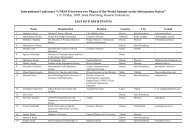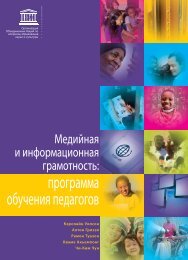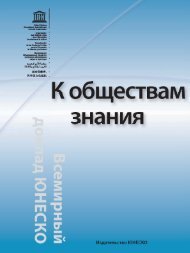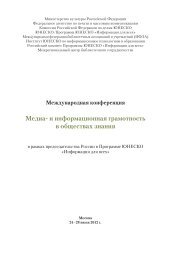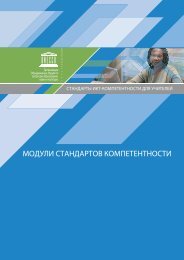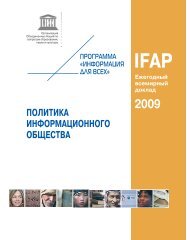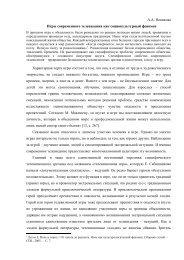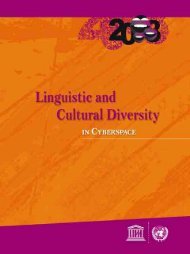Download - РоÑÑийÑкий комиÑÐµÑ ÐÑогÑÐ°Ð¼Ð¼Ñ Ð®ÐÐСÐÐ ...
Download - РоÑÑийÑкий комиÑÐµÑ ÐÑогÑÐ°Ð¼Ð¼Ñ Ð®ÐÐСÐÐ ...
Download - РоÑÑийÑкий комиÑÐµÑ ÐÑогÑÐ°Ð¼Ð¼Ñ Ð®ÐÐСÐÐ ...
You also want an ePaper? Increase the reach of your titles
YUMPU automatically turns print PDFs into web optimized ePapers that Google loves.
north Karelian, Livviks and Ludiks. Karelian language belongs to the Baltic-<br />
Finnic branch of the Finno-Ugrian languages, and the term in its broad meaning<br />
includes all three dialects. Vepsians belong to the indigenous small-numbered<br />
peoples of the North, Siberia and the Far East of the Russian Federation 81 .<br />
According to the 2002 All-Russian census, there are less than nine thousand<br />
Vepsians in Russia, 4,870 of them living in the Republic of Karelia (0.7% of<br />
the republic’s population). Karelia is a specific territory of the Russian North<br />
preserving unique culture of the Pomors – an ethnographic group of Russians<br />
with its own subdialect, customs and traditions formed in the course of the<br />
territory expansion and development.<br />
These ethnoses have left rich historical and cultural heritage for their<br />
offsprings that serves as an inexhaustible source of our region’s development.<br />
The heritage includes world famous cultural artifacts and landmarks, namely<br />
the Church of the Transfiguration on the Island of Kizhi; the Sheltozero Veps<br />
Ethnographic Museum; the Vodlozero National Park – the largest national<br />
park in Europe and the Paanajarvi National Park known as the “Pearl of the<br />
North”; religious buildings and structures of Zaonezhje and the Karelian<br />
petroglyphs, unique memorials of monument art of the late Stone Age (IV-<br />
II millennia B.C.). Karelian historical and cultural heritage is concentrated<br />
mainly in little towns and rural areas. There are over 150 towns, villages and<br />
settlements in Karelia with great history and significant cultural potential.<br />
They differ in building patterns, planning, natural surroundings, traditional<br />
arts and crafts, folk songs and dances.<br />
Preserving and promoting linguistic and cultural diversity and supporting the<br />
region’s identity are therefore major lines of action for the research, education<br />
and cultural institutions of the republic, as well as its NGOs.<br />
Karelia is facing demographic problems today. According to the all-Russian<br />
census in 2002 the republic’s population totaled 716,300 (0.5 % of the Russian<br />
Federation population), with Russians accounting for 76.6 %, Karelians for<br />
9.2 %, Vepsians for 0.7 %. Preliminary figures of the 2010 census indicate a<br />
significant population decline down to 647,000.<br />
According to a 2010 survey results 60% of Karelians and Vepsians living in<br />
the republic read newspapers and magazines in their mother tongues, 75 % –<br />
watch TV programmes and listen to radio broadcasts in mother tongues. 80 %<br />
of Karelians and Vepsians deem their right to use mother tongue is regarded.<br />
There are, however, issues for concern. One in five Karelians and one in<br />
three Vepsians polled expressed their concern over the sustainability of their<br />
mother tongue. About 40% of Karelians and 30% of Vepsians mentioned their<br />
81<br />
Unified Register of Indigenous Small-Numbered Peoples of the Russian Federation (Decree of the Russian<br />
Government Nr 536-r of 17 April 2006)<br />
232




